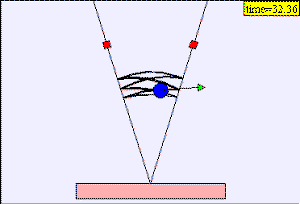

[A ball bouncing in a wedge.]
We study ODE event models and show how they can be used to detect hard disk collisions in models such as the ideal gas and Newton's cradle. We also introduce discrete maps and describe their connection to Poincare sections.
Ball Bounce in Wedge models the dynamics of a ball falling and bouncing elastically in a symmetric wedge. Although the ball's free-fall trajectory and bounce are simple and are discussed in introductory physics textbooks, the ball-wedge system exhibits a rich array of periodic and chaotic behavior and is of current research interest.
The ball has both chaotic and periodic trajectories but it is difficult to find initial conditions (x0, vx0, y0, vy0) that lead to periodicity. The "trick" is to examine the dynamics when the ball collides with the wall. At the time of collision, we record the ball's velocity component tangent to the wall vr and its velocity component perpendicular to the wall vn. A plot of vr vs. vn2 at the time of impact, known as a Poincaré section, provides a stroboscopic snapshot of the ball's state. The measured velocity components determine the ball's position because we can compute the ball's kinetic energy and use conservation of energy to compute the ball's height. The x-coordinate is computed using the y-coordinate and the wedge angle.
Run the Ball in Wedge model and observe the patterns. If the motion is periodic, the snapshot (Poincaré section) will show only a small number of points corresponding the number of collisions within the periodic orbit. If the trajectory is chaotic there the points on the plot will appear to be random. Initial conditions are selected by dragging the ball or by clicking within the Poincaré plot. Notice the symmetry of the patterns. Clicking at the center of an oval reveals the periodic trajectory.
The following models use ODE events to detect collisions between hard objects (disks or spheres).
The following models investigate iterative maps:
The following dynamical systems are investigated using Poincare maps:
Additional models may be be posted for self-study
The Model was created by Wolfgang Christian using the Easy Java Simulations (EJS) version 4.1 authoring and modeling tool. You can examine and modify a compiled EJS model if you run the model (double click on the model's jar file), right-click within a plot, and select "Open Ejs Model" from the pop-up menu. You must, of course, have EJS installed on your computer.
Information about Ejs is available at: <http://www.um.es/fem/Ejs/> and in the OSP comPADRE collection <http://www.compadre.org/OSP/>.